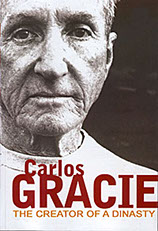Brazilian Jui-Jitsu
 Brazilian Jiu-Jitsu (BJJ) is a martial art, combat sport, and a self defense system that focuses on grappling and especially ground fighting. Brazilian jiu-jitsu was formed from early 20th century Kodokan Judo ground fighting (Ne-Waza) fundamentals that were taught to, Luiz França and Carlos Gracie by master Mitsuyo Maeda. Brazilian jiu-jitsu eventually came to be its own art through the experimentations, practices, and adaptation from the Judo knowledge of Carlos and Hélio Gracie, who then passed their knowledge on to their extended family.
Brazilian Jiu-Jitsu (BJJ) is a martial art, combat sport, and a self defense system that focuses on grappling and especially ground fighting. Brazilian jiu-jitsu was formed from early 20th century Kodokan Judo ground fighting (Ne-Waza) fundamentals that were taught to, Luiz França and Carlos Gracie by master Mitsuyo Maeda. Brazilian jiu-jitsu eventually came to be its own art through the experimentations, practices, and adaptation from the Judo knowledge of Carlos and Hélio Gracie, who then passed their knowledge on to their extended family.
BJJ promotes the concept that a smaller, weaker person can successfully defend against a bigger, stronger assailant by using leverage and proper technique, taking the fight to the ground – most notably by applying joint-locksand chokeholds to defeat the other person. BJJ training can be used for sport grappling tournaments (gi and no-gi) and mixed martial arts (MMA) competition or self-defense. Sparring (commonly referred to as “rolling”) andlive drilling play a major role in training, and a premium is placed on performance, especially in competition, in relation to progress and ascension through its ranking system.
Since its inception in 1882, its parent art of Judo was separated from older systems of Japanese ju-jitsu by an important difference that was passed on to Brazilian jiu-jitsu: it is not solely a martial art: it is also a sport; a method for promoting physical fitness and building character in young people; and, ultimately, a way (Do) of life.
Style of fighting
Upholding the premise that most of the advantage of a larger, stronger opponent comes from superior reach and more powerful strikes, both of which are mitigated when grappling on the ground, Brazilian jiu-jitsu emphasizes getting an opponent to the ground in order to use ground fighting techniques and submission holds involving joint-locks and chokeholds. A more precise way of describing this would be to say that on the ground, physical strength can be offset or enhanced by an experienced grappler who knows how to maximize force using mechanical advantage instead of pure physical strength.
BJJ permits a wide variety of techniques to take the fight to the ground after taking a grip. While other combat sports, such as Judo and Wrestling almost always use a takedown to bring an opponent to the ground, in BJJ one option is to “pull guard.” This entails obtaining some grip on the opponent and then bringing the fight or match onto the mat by sitting straight down or by jumping and wrapping the legs around the opponent.
Once the opponent is on the ground, a number of maneuvers (and counter-maneuvers) are available to manipulate the opponent into a suitable position for the application of a submission technique. Achieving a dominant position on the ground is one of the hallmarks of the BJJ style, and includes effective use of the guard (a signature position of BJJ) position to defend oneself from bottom (using both submissions and sweeps, with sweeps leading to the possibility of dominant position or an opportunity to pass the guard), and passing the guard to dominate from top position with side control, mount, and back mount positions. This system of maneuvering and manipulation can be likened to a form of kinetic chess when used by two experienced practitioners. A submission hold is the equivalent of checkmate in the sport, reflecting a disadvantage which would be extremely difficult to overcome in a fight (such as a dislocated joint or unconsciousness).
Renzo Gracie wrote in his book Mastering Jiu-Jitsu:
“The classical jujutsu of old Japan appeared to have no common strategy to guide a combatant over the course of a fight. Indeed, this was one of Kano’s most fundamental and perceptive criticisms of the classical program.’ Maeda not only taught the art of judo to Carlos Gracie, but also taught a particular philosophy about the nature of combat developed by Kano, and further refined by Maeda based on his worldwide travels competing against fighters skilled in a wide variety of martial arts.”
The book details Maeda’s theory as arguing that physical combat could be broken down into distinct phases, such as the striking phase, the grappling phase, the ground phase, etc. Thus, it was a smart fighter’s task to keep the fight located in the phase of combat that best suited to his own strengths. Renzo Gracie stated that this was a fundamental influence on the Gracie approach to combat, these strategies were further developed over time by the Gracie's and others, and became prominent in contemporary MMA.
SPACER
Free Intro Lesson
Try out our
great classes!
The intro class is a one-time 30 min class outlining the discipline, Brazilian Jiu Jitsu, Mixed Martial Arts, Muay Thai, Kickboxing or Wrestling.
This class serves as a preparatory class to those interested in seriously enrolling at the academy and training.
SIGN UP TODAY!
© 2021/2022 RGA Middletown
Operating Hours
- Mon & Wed & Fri
- 9:30 AM - 12:-30 PM
- 3:00 PM - 10:00 PM
- Tues & Thurs
3:00 PM - 10:00 PM - Saturday
9:30 AM - 5:00 PM - Sunday
By appointment
only for competition training
Daily Class Schedule
MONDAY
TUESDAY
WEDNESDAY
THURSDAY
FRIDAY
SATURDAY


